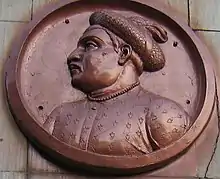Ranoji Scindia
Ranoji Shinde was the founder of the Scindia dynasty, a Maratha clan that produced outstanding Maratha military commanders during the 18th century. Later the Scindia served as vassals of the British from the northern Princely state of Gwalior.
| Ranoji Scindia | |
|---|---|
| Sardar | |
 A plaque outside Shaniwar Wada in Pune | |
| Reign | 1731–1745 |
| Successor | Jayappaji Rao Scindia |
| Born | c. 1700 |
| Died | 3 July 1745 (aged 44–45) Shujalpur, Malwa |
| Spouse | Maina Bai Chima Bai |
| Issue | Jayappaji Rao Scindia Dattaji Rao Scindia Jyotiba Rao Scindia Tukoji Rao Scindia Mahadji Shinde |
| House | Shinde |
| Father | Jankoji Shinde (I) |
| Religion | Hinduism |
Early life
Ranoji Scindia was born to a Marathi family, who were the hereditary Patils of Kanherkhed, a village in present day Satara district in the Indian state of Maharashtra. The Shinde family in the previous centuries had served as shiledars (cavalrymen) under the Bahmani Sultanate.[1]
Career
As a young man, Ranoji started in the service of Balaji Vishwanath Peshwa.[2] At that time Ramchandrababa Sukhtankar, one of the Peshwa's diplomats, recognised Ranoji's talents and had him made the personal servant of the Peshwa's son, Bajirao I.[3][4][5][6] Upon the death of his father, Bajirao was appointed as the Peshwa at the age of twenty by Chhatrapati Shahu. This evoked jealousy from senior officials at the Maratha court. This in turn led Baji Rao to promote talented young men who were barely out of teens such as Ranoji, Malhar Rao Holkar, the Pawar brothers, Pilaji Jadhav, and Fateh Singh Bhosle as commanders of his troops. None of these men belonged to families that held hereditary Deshmukhi rights under earlier rulers such as the Deccan Sultanates.[7][8][1][5] Ranoji, along with Malharrao Holkar and Pawar brothers, was in charge of the Maratha campaign initiated by Peshwa Bajirao in Malwa in 1726. Ranoji established his capital at Ujjain in 1731. He appointed Ramchandrababa Sukhtankar as his dewan, or administrator, and Made Yashaji Rambhaji sarsenapati of his army, while he spent most of his life on military campaign.[9] Some historians credit Sukhtankar with bringing the Kumbh mela to Ujjain in 1732.[10][11] [12] An early account of the Haridwar Kumbh Mela was published by Captain Thomas Hardwicke in 1796 CE.[12]
Family
Ranoji had five sons: Jayappajirao, Jyotibarao, Dattajirao, Tukojirao, and Mahadji Shinde. The eldest four died fighting in various battles in northern India between 1750-1761. Mahadji, the youngest, had an illustrious career in the second half of the 18th century.[13] His descendants were the rulers of the Princely state of Gwalior during the British colonial period (1818-1947).
See also
References
- Richard M. Eaton (19 December 2005). A social history of the Deccan, 1300-1761: eight Indian lives. Cambridge University Press. pp. 188–. ISBN 978-0-521-25484-7. Retrieved 16 July 2011.
- Rathod, N.G., 1994. The Great Maratha Mahadaji Scindia. Sarup & Sons.page=1-5
- Ainslie Thomas Embree (1988). Encyclopedia of Asian history. Scribner. p. 14. ISBN 978-0-684-18899-7.
Ranoji Scindia (d. 1750), the founder of Gwalior state, started his political career reputedly as a slipper-bearer at the court of the peshwa, or prime minister, of the Marathas, but soon rose to high office.
- K. V. Krishna Ayyar (1999). The Zamorins of Calicut: From the Earliest Times Down to A.D. 1806. Publication Division, University of Calicut. ISBN 978-81-7748-000-9.
The carrying of the Pallimaradi before the Zamorin on public occasions might have been due to the same reason as the carrying of a pair of golden slippers before Scindia , whose ancestor was the slipper - bearer of Peshwa Baji Rao - to show his respect for his original humble office which was the cause of his subsequent success
- Satish Chandra (2003). Essays on Medieval Indian History. Oxford University Press. p. 93. ISBN 978-0-19-566336-5.
The Sindhias, it is well-known, were drawn from a Kunbi family which had the hereditary patel-ship of Kumberkerrab in the district of Wai. The origins of the Holkar were even more humble: they belonged to the caste of goat-herds (dungar), the family holding zamindari rights in the village of Hal.
- Romila Thapar (1994). "Seminar - Issues 417-424": 59.
Many peasant caste men who distinguished themselves in battle or otherwise served the ruler became Marathas . Witness the first Holkar who was a shepherd and the first Scindia who was a Kunbi personal servant of the Peshwa
{{cite journal}}: Cite journal requires|journal=(help) - Gordon, Stewart (2007). The Marathas 1600–1818. Cambridge [u.a.]: Cambridge University Press. pp. 117–121. ISBN 978-0521033169.
- Sardesai, Govind Sakharam (1946). New History of the Marathas: The expansion of the Maratha power, 1707-1772. Phoenix Publications. pp. 65, 69.
- Rathod, N.G., 1994. The Great Maratha Mahadaji Scindia. Sarup & Sons.page=1-5
- Pandey, J., 2007. The ‘Habitus’ and ‘Doxa’of Great Tradition of Kumbha Mela: Role of Shiva Legends. The Public. An International Refereed Research Journal, 6(2), pp.11
- MANIT, B., 2012. BACHELOR OF PLANNING (Doctoral dissertation, MAULANA AZAD NATIONAL INSTITUTE OF TECHNOLOGY).
- James Lochtefeld (2008). Knut A. Jacobsen (ed.). South Asian Religions on Display: Religious Processions in South Asia and in the Diaspora. Routledge. pp. 31–33. ISBN 978-1-134-07459-4.
- Rathod, N.G., 1994. The Great Maratha Mahadaji Scindia. Sarup & Sons.page=1-5